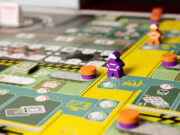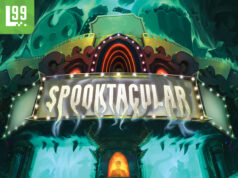Note: This preview uses pre-release components and rules. What you see here may be different from the final, published game. This post was a paid preview, you can find out more information here.
 You may have heard of designer Marc André. If you haven’t, he made this little game called Splendor and it’s done pretty well for itself. Soul Raiders is his next endeavor, which brings players into a fantastical world where they’ll become warrior mages called, well, Soul Raiders. It combines cooperative fantasy RPG, storytelling, and branching choices. But your choices won’t be arbitrary and not as easy as “go to page whatever”.
You may have heard of designer Marc André. If you haven’t, he made this little game called Splendor and it’s done pretty well for itself. Soul Raiders is his next endeavor, which brings players into a fantastical world where they’ll become warrior mages called, well, Soul Raiders. It combines cooperative fantasy RPG, storytelling, and branching choices. But your choices won’t be arbitrary and not as easy as “go to page whatever”.
You’ll have to manage your hand, help your companions, and ultimately complete your chapter’s victory condition. Soul Raiders will comprise of three chapters, which players will work through with increasing length and difficulty. The main narrative is going to be an integral part of the game. As such, I was given a prelude, so this preview will be spoiler-free and will give you a sense of how the game plays.
Gameplay Overview:
Soul Raiders allows gameplay with one to four players. Each character has a unique deck and special skills. I think regardless of the number of people you’re able to play with, the experience will be equally challenging and enjoyable. The rules don’t alter depending on player count. The only change is going to be the victory condition requirement, as this becomes more difficult with each additional player.

So, what does a turn look like? It’s pretty easily broken down into three phases: preparation, action, and reaction. In the preparation phase, players will refresh their hands and draw up to their maximum hand sizes, as well as get rid of any temporary spells from the previous round. During the action phase, players are taking actions with their cards to make story decisions, fight enemies, or help another player. The interesting thing about this phase is that players can work as independently or cooperatively as they wish. They don’t have to wait for their neighbor to take their turn, as everyone will be taking turns at the same time. But once all players have expended their cards, the phase ends.
Last is the reaction phase, and there’s a lot happening during this time. The group loses vitae or hit points based on how threatening their current situation is, as well as if players are engaged with enemies. Locations may also trigger effects, such as summoning more monsters, raising the threat level, or even flipping a location over to its alternative side. After all this, the victory condition is checked, and depending on its result, players will either win, keep playing starting with a new preparation phase, or lose.

Gameplay Impressions:
There are a few things Soul Raiders brings to the experience that I enjoyed and wanted to highlight. First, the game has multi-use cards. Multi-use cards aren’t something new, but the variety of their uses forced me to consider my options, such as “do I use this card’s bonus to wipe out some enemies?”, “do I risk going through this door with my last card, only to risk negative consequences?”, or “do I have enough to interrogate that goblin and leave without setting off an alarm?”. I like having a variety of options on my turn and these cards coupled with how the game uses them made for some interesting choices.
Story and text are something I typically skim over in a game. Unless it has vital information, I don’t usually take it in. Here, you’ll have to engage with it. The story elements might alter a location’s condition, reveal a piece of the victory condition you needed, or spawn a special enemy. I had one instance where a trap door was even sprung on me in the middle of my turn! Thankfully I was able to deal with it, but the story elements made for a very interesting and at times unpredictable game.

Certainly, the delivered game of Soul Raiders will have a bigger story than what I experienced, and I’d be interested to see how it handles multiple plays of the game. I should mention these story cards are not just a random deck you’re drawing from. They are numbered, so your responses and actions will have you drawing specific cards. For example, I interrogated a goblin, thinking I’d get some helpful information. But what I got was enemies and a location that would punish me if I stayed. But it also provided an opportunity for the story to continue, that is if I killed the specially spawned creature. That was really neat.
Soul Raiders is not a game that allows players to sit around and will not drag out the game. Each round, vitae is lost, inching the game closer to an ending if players can’t complete the victory condition. Crossing a certain threshold on lost vitae will lessen the cards players can draw each prep phase, making their task more difficult. If losing life and playing with fewer cards wasn’t enough, threats increase on the threat tracker, further inching the game toward an ending. I think this will be a good mechanic to keep games moving, especially with higher player counts. It will keep it from overstaying its welcome and will maintain some good tension.

I mentioned earlier that Soul Raiders has RPG elements to it. Each character will have the deck they start out with and some character bonuses, which will help them complete feats, such as climbing a mountain or picking a lock. This helps give characters some unique contribution to the group. Throughout the game, players will also earn coins that can be used to add heroic cards to their decks for one-time use or ongoing aid. The coins can also be very helpful later in a chapter, as they can allow you to draw and play more cards. This was really helpful for me, especially towards the end when I only had two cards and limited options to deal with five monsters. And let me tell you, there is nothing more satisfying than top-decking a powerful spell that wipes out a bunch of low-level monsters.
Final Thoughts:
After playing Soul Raiders, I felt like I had just played a board game version of Diablo or Baldur’s Gate. This was “choose your own adventure” on steroids. The choices you’ll be presented with each round will change and challenge. The game is always moving forward despite any indecision you might want to have. There are interesting options for pushing your luck and managing your hand that may or may not pay off. I’ll be interested in how other aspects of this game I didn’t have an opportunity to explore will influence the final experience, such as potions, quests, and artifacts. But what I played so far was a very fun experience that fans of this genre will enjoy.
Soul Raiders launches today on Kickstarter. Head over to the campaign page for more information, or to become a backer.






















